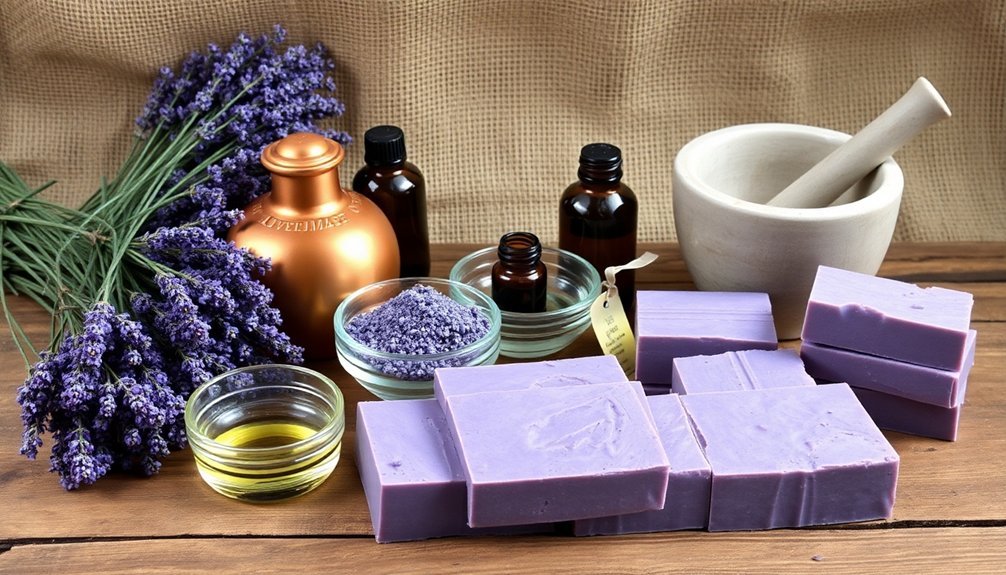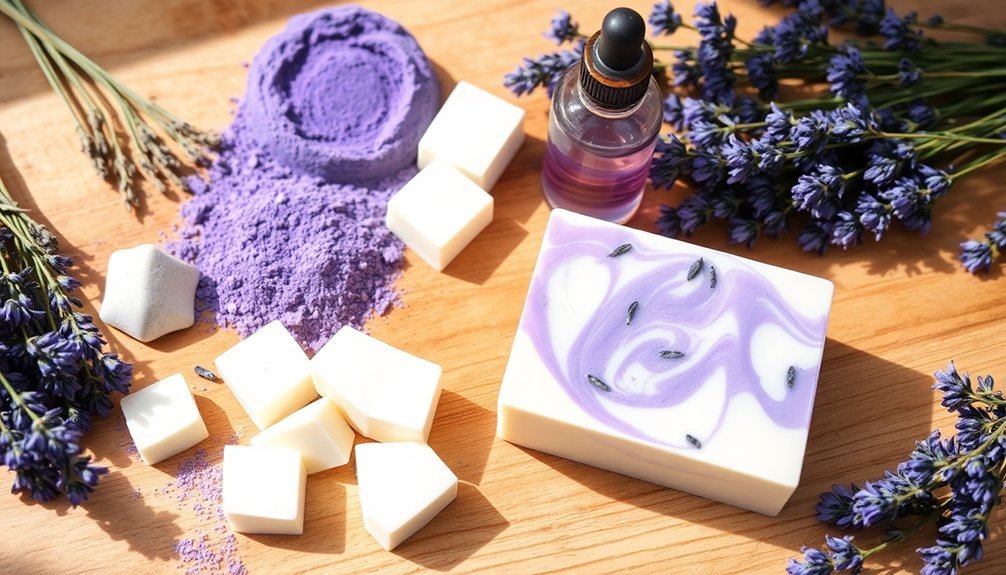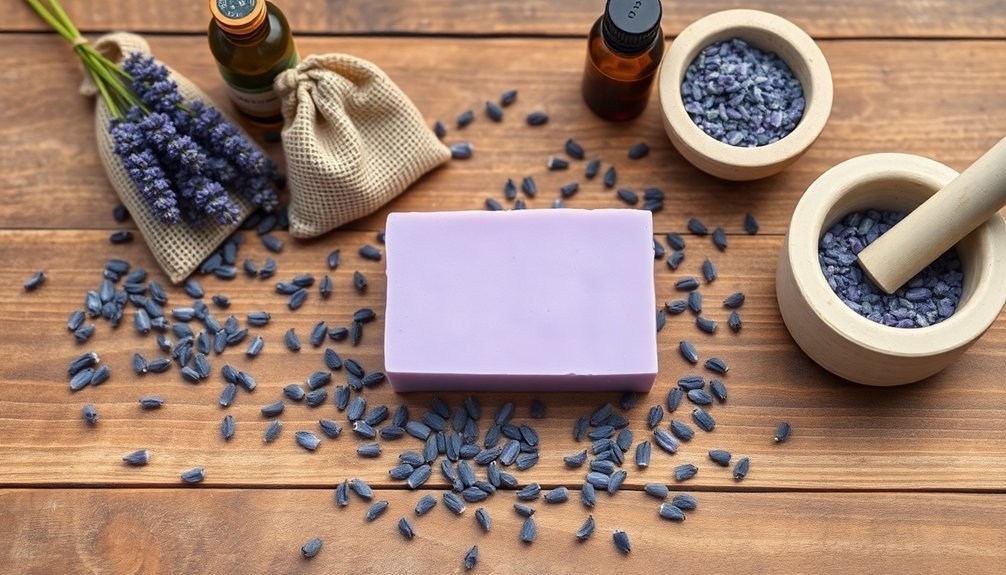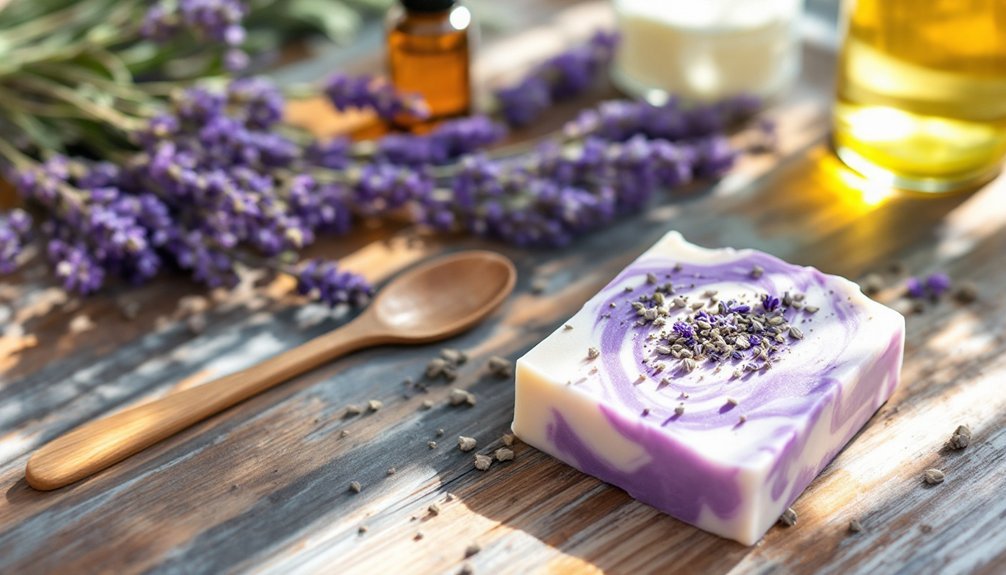Pure handmade lavender soap typically contains lavender essential oil (about 3% of total oils), a base of olive oil (50%), coconut oil (28%), shea butter (11%), and castor oil (10%), plus sodium hydroxide (lye). You'll often find natural colorants like purple clay or alkanet root, and sometimes dried lavender buds for decoration. Therapeutic additives may include honey, oatmeal, or aloe vera for enhanced skin benefits. The perfect balance creates a soap that's both luxurious and healing.
The Essential Oils That Define Lavender Soap

Essence is everything when it comes to crafting authentic lavender soap. The star ingredient in handmade lavender soap is without a doubt lavender essential oil, typically extracted from Lavandula angustifolia.
When making your soap, you'll want to incorporate this precious oil at approximately 3% of your total oil weight to achieve the perfect fragrance balance.
You'll benefit from lavender's impressive therapeutic properties, including acne clearance and eczema calming. These skin benefits make it a standout ingredient in natural skincare.
If you're sensitive, be aware of common allergens like geraniol, limonene, and linalool.
For a gentler alternative, consider using lavender-infused oil in your soap making process. While it won't deliver the same potent scent, it offers a subtle lavender experience that still contributes to skin health.
Base Carrier Oils: Building the Perfect Lavender Bar
While essential oils provide the signature scent, it's the carrier oils that form the foundation of your lavender soap's quality and performance.
In pure handmade lavender soap, olive oil typically makes up about 50% of the base carrier oils, delivering exceptional skin-softening and antioxidant benefits.
Coconut oil (around 28%) creates a hard bar with the bubbly, creamy lather you love, while shea butter (approximately 11%) infuses your handmade soap with nourishing vitamins and luxurious feel.
Don't overlook castor oil—this moisturizing powerhouse constitutes about 10% of the formula, enhancing the lathering experience while adding hydration.
Together, these carefully balanced base carrier oils transform simple lavender soap into a nourishing skin treatment that cleanses without stripping natural moisture.
Natural Colorants for Authentic Purple Hues

You'll find several options for achieving that perfect purple in your lavender soap, including natural clays, plant powders like alkanet root, or cosmetic-grade ultramarines and micas.
When choosing between these colorants, consider how alkanet needs at least 30% infused oil for deep purple hues, while Brazilian purple clay offers consistency but requires vetting your supplier carefully.
Experiment with layering different purple tones in your soap for visual depth that complements your lavender scent profile.
Clay vs. Plant Powders
When creating authentic purple hues in your lavender soap, you'll need to choose between mineral-based options like purple Brazilian clay and plant-derived colorants such as alkanet root.
Purple Brazilian clay offers dual benefits – it provides a natural lavender tone while delivering skin benefits at about one teaspoon per pound of oils in your soap recipe.
For deeper purple hues in your pure handmade lavender soap, consider alkanet root infused oil. It requires patience – at least one month of infusion time – but rewards you with rich color variations depending on the ratio used.
Alternatively, butterfly pea flower plant powders create vibrant blue tones that shift to purple when combined with acidic ingredients.
Remember that color longevity varies with each natural colorant, as pH levels and light exposure can affect their stability over time.
Ultramarines and Micas
Although commonly used in artisanal soap making, ultramarines aren't truly natural colorants despite their mineral origins. They do, however, create vibrant purple hues that make your lavender soap visually striking.
Micas offer a natural alternative as they're genuine mineral pigments that provide both color and shimmer. When you're selecting colorants, always choose soap-safe varieties to prevent skin irritation.
| Colorant | Properties | Best Uses |
|---|---|---|
| Ultramarines | Synthetic mineral, vibrant | Bold purple tones |
| Micas | Natural, shimmery | Pearlescent effects |
| Plant Powders | All-natural, subtle | Organic formulations |
| Blended Options | Customizable | Unique color patterns |
Test colorants in small batches first—your soap's pH affects the final color. Both ultramarines and micas help create authentic purple soap that enhances your product's visual appeal.
Layering Purple Tones
Natural colorants offer depth and authenticity that synthetic alternatives simply can't match in artisanal lavender soap.
Alkanet root infusion stands out as a premier choice for achieving true purple hues in your pure lavender soap. For best results, infuse alkanet in your soap oils for at least 30% of the total time, allowing the vibrant purples to fully develop.
Brazilian purple clay provides another excellent option, though you'll want to verify quality sources when purchasing online.
Whichever natural colorant you choose, uniform blending with your soap batter is essential for consistent color distribution.
For enhanced visual appeal, consider layering techniques by combining different purple intensities or incorporating lavender buds as accents.
This multi-dimensional approach creates depth while maintaining the natural essence that makes handcrafted lavender soap so special.
Dried Lavender Buds: Decoration vs. Function

Many soap makers debate whether to incorporate dried lavender buds for their beauty or their utility. When crafting your handmade lavender soap, these natural elements serve primarily as a decorative element that visually signals the lavender scent inside. You'll want to place them on top rather than mixing them into the soap itself, as they tend to brown upon contact with soap base.
| Aspect | On Top of Soap | Mixed Into Soap |
|---|---|---|
| Appearance | Maintains purple color | Browns quickly |
| Function | Purely decorative | Adds exfoliating properties |
| Application | Apply with rubbing alcohol | Not recommended |
For the most inviting visual presentation, use small amounts of dried lavender buds to enhance aesthetic value without overpowering the delicate scent profile of your handmade creation.
Therapeutic Additives That Complement Lavender
Beyond the visible appeal of lavender buds, the therapeutic value of your handmade soap can be greatly enhanced with thoughtfully selected additives.
Honey can boost the moisturizing properties of your lavender essential oils, providing additional nourishment while soothing your skin. Incorporating oatmeal offers gentle exfoliation and complements lavender's calming effects, especially for irritated skin.
For deeper hydration, aloe vera gel reduces inflammation and enhances healing benefits.
You'll find that chamomile essential oil creates a synergistic effect with lavender, amplifying its skin-soothing qualities and promoting relaxation.
Don't overlook shea butter, which contributes to a creamy lather while delivering vitamins and fatty acids that improve skin elasticity and softness.
These therapeutic additives work harmoniously with lavender to create a soap that's not just cleansing but truly beneficial for your skin.
Lye Calculations and Water Substitutions for Lavender Soap

When working with lye for your lavender soap, always wear protective gear and mix it slowly into water—never the reverse—in a well-ventilated area.
You'll need to calculate your oil-to-lye ratio precisely using a saponification calculator, ensuring your soap won't be harsh or too soft.
For a unique twist, try substituting distilled water with homemade lavender tea, which won't affect the scent but adds a personal touch to your creation.
Essential Lye Safety Measures
How carefully have you considered your lye calculations for lavender soap making?
Working with this caustic substance requires precise safety protocols to prevent injury. Always use a reliable lye calculator to determine the exact amount needed based on your oils' saponification values.
When handling lye, follow these critical safety steps:
- Wear protective gloves, safety goggles, and long sleeves to shield your skin.
- Measure ingredients by weight, not volume, for accurate measurement.
- Always add lye to water (never reverse) and stir with a heat-resistant utensil.
- Work in a well-ventilated area away from children and pets.
If you're substituting lavender tea for water, maintain the proper ratio to guarantee complete chemical reactions.
A slight water discount can produce harder bars, but don't compromise the chemistry that makes soap safe.
Lavender Tea Water Replacement
Many soap crafters elevate their lavender soaps by substituting traditional water with homemade lavender tea. To prepare this water replacement, steep dried or fresh lavender in scalding water, then strain before measuring. You'll need to maintain the exact same liquid weight in your lye solution for proper saponification.
| Lavender Tea Tips | Safety Considerations |
|---|---|
| Replace water 1:1 by weight | Mix in well-ventilated area |
| Strain tea thoroughly | Solution will still heat up |
| Adds light beige color | Maintain protective equipment |
When you're preparing your lye solution with lavender tea, you're adding a personal touch that enhances the aesthetic appeal of your final product. The light beige color creates a natural look that complements the lavender soap's overall charm, without affecting the scent profile you've carefully crafted.
Oil-to-Lye Ratio Formulation
Now that you understand how to enhance your lavender soap with tea water, let's focus on the scientific foundation of any successful soap formula – the oil-to-lye ratio. This calculation is critical for handmade soap safety and effectiveness.
Always measure by weight when formulating your lavender soap recipe. A typical blend might use 29 oz of oils requiring approximately 4 oz of lye, but this varies based on specific saponification values.
For perfect lavender soap, follow these essential steps:
- Calculate lye amounts precisely based on each oil's saponification value.
- Prepare lye solution using a 2:1 water-to-lye ratio.
- Adjust calculations when using sodium lactate for harder bars.
- Balance liquid oils with solid oils to prevent excess lye.
Remember that even when adding lavender essential oil, maintaining the correct oil-to-lye ratio guarantees safe, beautiful soap.
Frequently Asked Questions
What Do I Need to Make Lavender Soap?
You'll need oils (olive, coconut, almond, sunflower), lye solution (sodium hydroxide with distilled water), lavender essential oil, and safety gear (gloves, goggles). Optionally, add purple Brazilian clay and dried lavender buds.
What Goes With Lavender in Soap?
You can pair lavender with chamomile, bergamot, or eucalyptus oils for enhanced calming effects. Natural colorants like alkanet root, moisturizing oils such as jojoba, and additives like honey or dried botanicals work beautifully too.
Why Does My Lavender Soap Turn Brown?
Your lavender soap turns brown because of natural oxidation. Lavender buds and essential oils react with oxygen, especially when exposed to moisture and air. Using dried buds mixed within soap rather than on top accelerates this process.
What Is the Natural Colorant for Lavender Soap?
You'll find alkanet is the most popular natural colorant for lavender soap, giving it a deep purple hue. You can also try Brazilian purple clay or gromwell root for beautiful lavender shades in your soaps.
In Summary
You've discovered all the elements that transform simple soap into pure handmade lavender luxury. From essential oils and nourishing carriers to natural colorants and therapeutic additives, you're now equipped to create or select the perfect lavender bar. Remember that precise lye calculations and thoughtful water substitutions are vital for achieving that perfect balance. Whether for gifts or personal use, your lavender soap knowledge will yield beautiful, aromatic results.





Leave a Reply